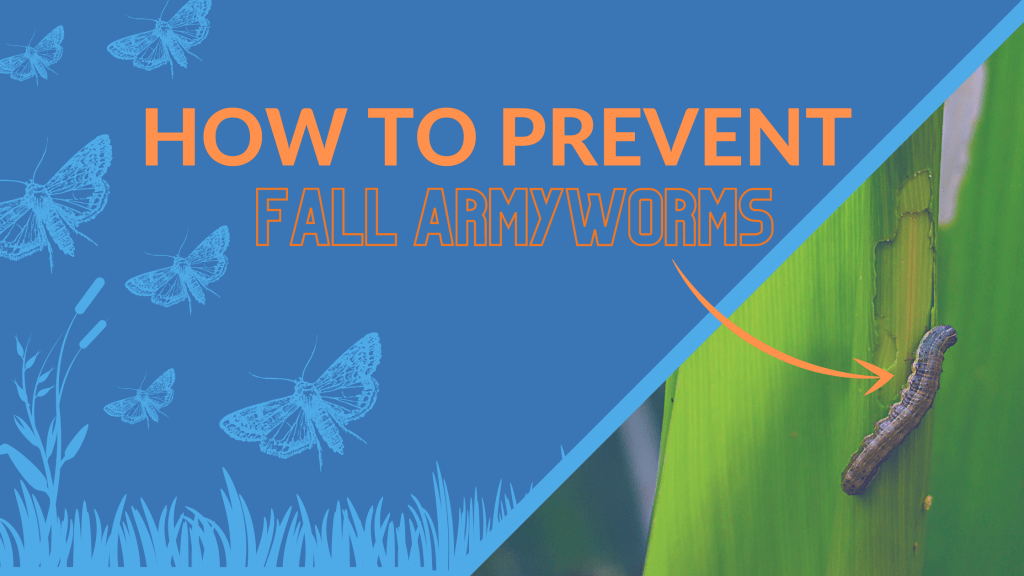How To Prevent Fall Armyworms From Destroying Your Lawn

Ohioan homeowners may soon start to see small brown patches showing up across their lawns. The culprits of these mysterious spots – troops of fall armyworms invading up across Ohio from the south! These undesirable visitors can quickly turn a lush, green lawn into a brown, mushy mess within just a day or two due to their impressive speed and high numbers. Here’s what you need to know to prevent fall armyworms from destroying your lawn.
What do fall armyworms look like?
The fall armyworms in their notable destructive larval stage are typically about 1.5 inches long and usually dark green or black with a yellow head.
They have a few distinctive features. One is their head, which has light markings that form an upside down “Y”. Another is their opposite end which has 4 black dots that form a square shape. They also have 3 stripes that run down the middle of their bodies.
How Do I know if I have Fall Armyworms around my home?
Here are a few of the most common signs to tell if you may have a fall armyworm infestation:
- Your sod has become discolored or looks like it’s been exposed to frost (the blades of grass appear crisp, lifeless, and a yellow, white, or brown color)
- Damage appears on a part of your lawn as small brown patches, particularly if you start noticing the damage spreading across the rest of your lawn instead of staying isolated to a particular area
- An abnormal number of birds start becoming attracted to your lawn. Fall armyworms are a food source to birds but unfortunately armyworm colonies are typically so large that birds themselves aren’t enough to keep infestations controlled.
Another way to find out if there are fall armyworms buried within your lawn is to do a “soap flush” test.
Soap Flush Test Recipe:
- 3 tablespoons of liquid dish soap (lemon scented is most effective!)
- 1 gallon of water
- A bucket or large container for mixing & pouring
Directions:
Combine the liquid dish soap and water. Pour the mixture into a 3 foot x 3 foot area on your lawn where you suspect fall armyworm activity (such as in an area with brown spots). The soap mixture works by agitating the outer skin of the larvae and they’ll come to the surface.
Note: the soap flush test may cause other types of insects to surface!
Should I be concerned if I see signs of Fall Armyworms on my lawn?
The short answer is, YES!
Fall armyworms can cause significant, costly damage to your lawn in a very short amount of time. These destructive lawn invaders are often found in large numbers (up to millions in a single colony). Fall armyworm larvae devour turf for an average of 14-28 days before continuing their transition into adult moths.
Once they hit maturity in moth-form, they can lay thousands of eggs. The eggs only need 3-5 days to hatch to create another armyworm generation, which goes through the 14-28 feeding cycle again. What this means is that a single fall armyworm invasion can turn into a long, drawn-out battle to recover your lawn.
While fall armyworm invasions do typically subside when the cold weather hits, the speed by which they go through their life cycles is still a concern. Multiple generations can attack and consume your entire lawn by the time we get our first frost.
Treating Fall Armyworms
Fall armyworms, while harmless to humans directly, are very aggressive in terms of how fast they destroy and spread. Because of this, you need to be fast and vigilant in how quickly you treat them.
There are a wide variety of retail insecticides available on the market but be sure to do your research and check the labels of any products you’re planning on using. Many commercial insecticides are broad spectrum and don’t just exclusively target fall armyworms. They may also kill predatory insects that help control other pests (the good guys that protect you), pollinators like bees, and even monarch butterflies.
For professional help managing fall armyworms or other fall pests, give go2-pros a call! Our pest control experts can help answer any questions you may have. If you’re having troubles controlling a fall armyworm invasion in your lawn, we’ll discuss what treatment options we have available to help.
